Natural
Pearls
Prior to the 19th century,
when they were superseded in price by diamonds, natural pearls had,
throughout history, been valued above all other gems. Although their
beauty, and the fact that they come out of the mollusk ready to use,
were important factors, it was sheer rarity that drove their value to
the highest levels. The formation of a large, beautiful and perfect
natural pearl is an event so
unlikely in Nature that only
those at the pinnacle of wealth and power in a society were able to
own them. Depending on the species between 1/1000 to 1/500,000
mollusks will form pearls during their lifespan, and the vast
majority of those formed will be small, off-color or flawed.
Nacreous Pearls
True pearls are referred
to as "nacreous pearls" due to their composition. Such a pearl is
formed when a small foreign object makes its way into the soft body
of a filter-feeding or grazing mollusk, and cannot be expelled. The
irritant is sometimes a stray bit of shell or bone, but more often a
parasite. Layers of calcium carbonate crystals and protein are
secreted to slowly cover all parts of the object which, then, becomes
a pearl. If it grows entirely within the body of the animal it will
be three-dimensional "cyst pearl", if it grows attached to the shell,
it will be a "blister pearl".
We can perhaps imagine the
awe and mystery that these objects held for the early peoples who
found and cherished them, and it is no wonder that mythic and
mystical explanations for their formation abounded. Picture
harvesting the creature shown below (not all pristine and clean, as
shown), but covered with mud and sea weed and inside its greyish,
lumpy and slimy interior, finding the iridescent object in the
adjacent photo.
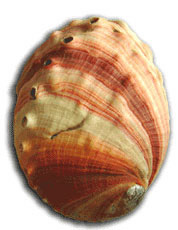
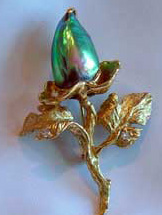 [Abalone shell, abalone pearl jewelry: Images
courtesy of www.allnaturalpearls.com]
The beauty of a nacreous
pearl comes from a combination of its shape, color, and surface
reflection (luster). In the best specimens these features are
heightened by a surface iridescence called "orient". The shape of a
pearl will largely be determined by chance (the shape of the
irritant), and its anatomical placement in the animal. The body color
will vary with the species of mollusk, which will generally make
pearls in shades similar to that of their shell lining. The
iridescence and/or luster of a pearl will be a consequence of the
perfection and thickness of the nacre layers, of which the onion-like
pearl is made.
Nacre (NAY-ker) is made up
of plate-like hexagonal crystals of translucent aragonite (a form of
calcium carbonate), conchiolin protien (konk-KY-oh-lin) and water.
Each crystal is very thin and they are layed down rather like bricks
in staggered courses with the proteinaceous "motar" between. Light,
reflecting and diffracting from the uneven surface, and the thin
inner layers creates the lovely effects of luster and
orient.
[Abalone shell, abalone pearl jewelry: Images
courtesy of www.allnaturalpearls.com]
The beauty of a nacreous
pearl comes from a combination of its shape, color, and surface
reflection (luster). In the best specimens these features are
heightened by a surface iridescence called "orient". The shape of a
pearl will largely be determined by chance (the shape of the
irritant), and its anatomical placement in the animal. The body color
will vary with the species of mollusk, which will generally make
pearls in shades similar to that of their shell lining. The
iridescence and/or luster of a pearl will be a consequence of the
perfection and thickness of the nacre layers, of which the onion-like
pearl is made.
Nacre (NAY-ker) is made up
of plate-like hexagonal crystals of translucent aragonite (a form of
calcium carbonate), conchiolin protien (konk-KY-oh-lin) and water.
Each crystal is very thin and they are layed down rather like bricks
in staggered courses with the proteinaceous "motar" between. Light,
reflecting and diffracting from the uneven surface, and the thin
inner layers creates the lovely effects of luster and
orient.
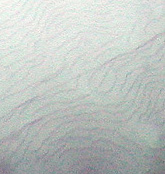 [Magnified surface of a pearl with its overlapping
layers of nacre: Image courtesy of Joe Mirsky]
Pearls are made by both
salt and freshwater bivalve (two shell: oysters and mussels) and
univalve (one shell: snail-like) mollusks. What we call saltwater
pearl "oysters", are not closely related to the edible varieties of
oyster. So, that plate of oysters you might enjoy for lunch, must
remain a gastronomic delight alone, as no pearl will be found in it.
If you are a freshwater mussel or saltwater abalone fan, however,
your chance of finding a pearl, though slim, exists, as long as you
eat them raw (cooking destroys pearls).
What's in a
name?
In today's world, the word
"pearl" means "cultured pearl" to almost everyone. Technically, it's
illegal to sell or advertise cultured pearls, as pearls, without
using the adjective "cultured", but no one really gets very excited
about enforcing it. In the present day, natural pearls, due to
overfishing and pollution, are even rarer than they
were in historical times. Their admirers are not so much the
wealthiest among us, as those who for philosophical,
spiritual/religious, or aesthetic reasons seek out these rarities.
This shift in the position of natural pearls from status symbol to
quasi-cult objects, has been the result of the spectacular success of
pearl culturing. With its technical beginnings around 1890 and large
scale production in force by the early 1920's pearl culturing has
made this gem one that is obtainable by virtually anyone in a variety
of qualities and prices.
How the
pearl marketplace has changed, then:
[Magnified surface of a pearl with its overlapping
layers of nacre: Image courtesy of Joe Mirsky]
Pearls are made by both
salt and freshwater bivalve (two shell: oysters and mussels) and
univalve (one shell: snail-like) mollusks. What we call saltwater
pearl "oysters", are not closely related to the edible varieties of
oyster. So, that plate of oysters you might enjoy for lunch, must
remain a gastronomic delight alone, as no pearl will be found in it.
If you are a freshwater mussel or saltwater abalone fan, however,
your chance of finding a pearl, though slim, exists, as long as you
eat them raw (cooking destroys pearls).
What's in a
name?
In today's world, the word
"pearl" means "cultured pearl" to almost everyone. Technically, it's
illegal to sell or advertise cultured pearls, as pearls, without
using the adjective "cultured", but no one really gets very excited
about enforcing it. In the present day, natural pearls, due to
overfishing and pollution, are even rarer than they
were in historical times. Their admirers are not so much the
wealthiest among us, as those who for philosophical,
spiritual/religious, or aesthetic reasons seek out these rarities.
This shift in the position of natural pearls from status symbol to
quasi-cult objects, has been the result of the spectacular success of
pearl culturing. With its technical beginnings around 1890 and large
scale production in force by the early 1920's pearl culturing has
made this gem one that is obtainable by virtually anyone in a variety
of qualities and prices.
How the
pearl marketplace has changed, then:

 [Circa
1890 2-3.5 mm, natural, saltwater pearl brooch, circa 1920 2.5 - 4
mm, natural saltwater 16" pearl necklace]
Natural
Pearls: Expensive then, expensive now!
[Circa
1890 2-3.5 mm, natural, saltwater pearl brooch, circa 1920 2.5 - 4
mm, natural saltwater 16" pearl necklace]
Natural
Pearls: Expensive then, expensive now!
And
now:
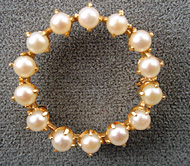
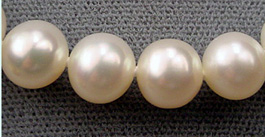 [Circa
1960 4 mm, cultured saltwater pearl brooch (fairly expensive when
new), 2005, 18" 7.5 mm, freshwater cultured pearl necklace (very
inexpensive)]
Cultured Pearls: Size is increasing and prices are
dropping!
In looking at the photos
above we can begin to see why cultured pearls have taken over the
world. Natural pearls are generally small, and vary in shape and
color, cultured pearls, especially in today's market, are uniform in
size, shape, and color and can be huge! It might
take an oyster in Nature six or seven years to make a 4 mm pearl, and
only 1-2 out of a hundred of them would be round. Furthermore, colors
are not uniform.
In today's market natural
pearls are available through current small scale (legal) harvesting,
and also as vintage and antique specimens or jewelry.
Examples of natural,
nacreous pearls:
[Circa
1960 4 mm, cultured saltwater pearl brooch (fairly expensive when
new), 2005, 18" 7.5 mm, freshwater cultured pearl necklace (very
inexpensive)]
Cultured Pearls: Size is increasing and prices are
dropping!
In looking at the photos
above we can begin to see why cultured pearls have taken over the
world. Natural pearls are generally small, and vary in shape and
color, cultured pearls, especially in today's market, are uniform in
size, shape, and color and can be huge! It might
take an oyster in Nature six or seven years to make a 4 mm pearl, and
only 1-2 out of a hundred of them would be round. Furthermore, colors
are not uniform.
In today's market natural
pearls are available through current small scale (legal) harvesting,
and also as vintage and antique specimens or jewelry.
Examples of natural,
nacreous pearls:
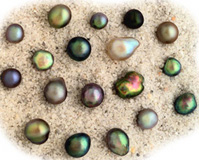
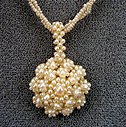
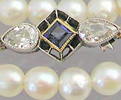
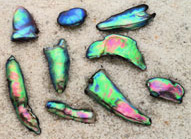
 [A
contemporary suite of saltwater pearls from the "Rainbow-lipped"
oyster: Image courtesy of www.allnaturalpearls.com, Victorian Era
seedpearl bride's necklace, Art Deco Era saltwater pearl necklace,
contemporary suite of abalone pearls: Image courtesy of
www.allnaturalpearls.com, circa 1905 gentleman's saltwater pearl
stickpin]
Are
they really natural?
If you're
in the market for antique jewelry with natural pearls you need to be
aware that imitation pearls have a long history and were sometimes used in
surprisingly "upscale" jewelry pieces. The "tooth-test" is generally
helpful (although not sanitary). The surface of a nacreous pearl
(natural or cultured) will be slightly gritty. This microscopic
roughness can be detected by rubbing the pearl, gently, across the
edges of your front teeth. Pearl simulants (usually made of glass or
shell) have smooth surfaces and don't feel rough. Also if the pearls
in your antique piece are uniform in size, luster and color your
"fraud antennae" should be on full alert.
Non-nacreous "pearls"
Technically, the product of a mollusk that is
not
made of nacre
is not a pearl, but a "calcareous concretion". Having said
that, I'll point out that they run the gamut from chalky marble like
products such as found in edible oysters with no gem value, to some
of the most highly valued and rare gems in the world. For the
purposes of this essay, I will call these beautiful and valuable
ones, "pearls".
There are
three of note: Conch pearls (pronounced "konk"), scallop pearls, and
melo melo pearls. Each of these is made of calcium carbonate but
primarily in the form of calcite rather than aragonite, and with
different structural characteristics and protein proportions than
their nacreous cousins.
Conch
pearls are products of a large marine snail, the queen conch, It is
native to the Caribbean and, until it was fished to near extinction,
was found abundantly in the waters of the Florida Keys. Ranging in
color from white to vibrant pink, the pearls are usually small (8 mm
is large) and ovoid. you can see in the picture below and to the
right, the highly desirable "flame structure" chatoyance that the
best specimens have. (Conch pearl lovers are not to blame for the
decimation of the Florida population, as they are basically just a
rare by-product of the hunt for this mollusk: the meat of the conch
is a delicacy, its pink shell lining is used in jewelry, especially
cameos and the shell itself is a tourist object.)
[A
contemporary suite of saltwater pearls from the "Rainbow-lipped"
oyster: Image courtesy of www.allnaturalpearls.com, Victorian Era
seedpearl bride's necklace, Art Deco Era saltwater pearl necklace,
contemporary suite of abalone pearls: Image courtesy of
www.allnaturalpearls.com, circa 1905 gentleman's saltwater pearl
stickpin]
Are
they really natural?
If you're
in the market for antique jewelry with natural pearls you need to be
aware that imitation pearls have a long history and were sometimes used in
surprisingly "upscale" jewelry pieces. The "tooth-test" is generally
helpful (although not sanitary). The surface of a nacreous pearl
(natural or cultured) will be slightly gritty. This microscopic
roughness can be detected by rubbing the pearl, gently, across the
edges of your front teeth. Pearl simulants (usually made of glass or
shell) have smooth surfaces and don't feel rough. Also if the pearls
in your antique piece are uniform in size, luster and color your
"fraud antennae" should be on full alert.
Non-nacreous "pearls"
Technically, the product of a mollusk that is
not
made of nacre
is not a pearl, but a "calcareous concretion". Having said
that, I'll point out that they run the gamut from chalky marble like
products such as found in edible oysters with no gem value, to some
of the most highly valued and rare gems in the world. For the
purposes of this essay, I will call these beautiful and valuable
ones, "pearls".
There are
three of note: Conch pearls (pronounced "konk"), scallop pearls, and
melo melo pearls. Each of these is made of calcium carbonate but
primarily in the form of calcite rather than aragonite, and with
different structural characteristics and protein proportions than
their nacreous cousins.
Conch
pearls are products of a large marine snail, the queen conch, It is
native to the Caribbean and, until it was fished to near extinction,
was found abundantly in the waters of the Florida Keys. Ranging in
color from white to vibrant pink, the pearls are usually small (8 mm
is large) and ovoid. you can see in the picture below and to the
right, the highly desirable "flame structure" chatoyance that the
best specimens have. (Conch pearl lovers are not to blame for the
decimation of the Florida population, as they are basically just a
rare by-product of the hunt for this mollusk: the meat of the conch
is a delicacy, its pink shell lining is used in jewelry, especially
cameos and the shell itself is a tourist object.)
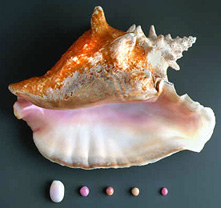
 [Strombus gigas, the Queen conch, with typical pearls: Image
courtesy of www.sunlion.com, three top quality conch pearls showing
"flame structure": Image courtesy of Aires Jewelers]
Scallop
pearls
The newest
type of natural pearl available to collectors is the scallop pearl.
It is found in a marine bivalve scallop that is native to the coast
of Baja California, and is just beginning to be harvested. Highly
variable in size and shape, they have mosaic-like patterns and cream
to salmon or mauve colors with a semi-metallic to chatoyant
sheen.
[Strombus gigas, the Queen conch, with typical pearls: Image
courtesy of www.sunlion.com, three top quality conch pearls showing
"flame structure": Image courtesy of Aires Jewelers]
Scallop
pearls
The newest
type of natural pearl available to collectors is the scallop pearl.
It is found in a marine bivalve scallop that is native to the coast
of Baja California, and is just beginning to be harvested. Highly
variable in size and shape, they have mosaic-like patterns and cream
to salmon or mauve colors with a semi-metallic to chatoyant
sheen.
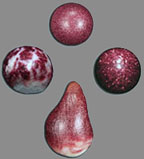
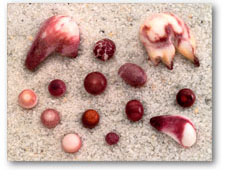 [Scallop pearls: Images courtesy of
www.allnaturalpearls.com]
Melo melo
pearls:
By far,
the hardest to obtain pearls on Earth are those of the marine "baler"
snail, found in the Indo-Pacific region: round, smooth and sometimes
quite large, I recently held one in my hand that was the size of a
large gumball and nearly dropped it when the price of $50,000 was
quoted to me. The colors and flame structure are similar to those of
the conch pearl.
[Scallop pearls: Images courtesy of
www.allnaturalpearls.com]
Melo melo
pearls:
By far,
the hardest to obtain pearls on Earth are those of the marine "baler"
snail, found in the Indo-Pacific region: round, smooth and sometimes
quite large, I recently held one in my hand that was the size of a
large gumball and nearly dropped it when the price of $50,000 was
quoted to me. The colors and flame structure are similar to those of
the conch pearl.
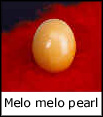
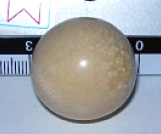 [Melo
melo pearl showing ideal color: Image courtesy of the Latendresse
family, Large 30 mm, 150 ct. Melo melo pearl: Image courtesy of
Gemopolitan.Ltd]
To this
date, none of the non-nacreous pearls have been successfully
cultured, and each has a unique structure which makes its difficult
to fake, so that there is little worry about synthetics and
simulants.
Value
It is difficut to talk,
except in generalities, about value for gemstones as rare and
variable as natural pearls. The nacreous ones increase exponentially
in value with size but luster, color and shape are important as well.
With the non-nacreous pearls, color and quality of the any surface
pattern or chatoyance are probably more important than
size.
Care
All pearls need gentle
care. They are soft, fragile, and are sensitive to chemicals,
especially acids. All the cleaning they ever need, is wiping with a
damp cloth after each wearing, and they should be stored away from
other gems, preferably in a cloth bag or their own case. Non-nacreous
pearls should not be exposed to bright light for extended periods as
the organic pigments which give them their colors can fade. Pearl
strands that are worn frequently should be restrung every few
years.
[Melo
melo pearl showing ideal color: Image courtesy of the Latendresse
family, Large 30 mm, 150 ct. Melo melo pearl: Image courtesy of
Gemopolitan.Ltd]
To this
date, none of the non-nacreous pearls have been successfully
cultured, and each has a unique structure which makes its difficult
to fake, so that there is little worry about synthetics and
simulants.
Value
It is difficut to talk,
except in generalities, about value for gemstones as rare and
variable as natural pearls. The nacreous ones increase exponentially
in value with size but luster, color and shape are important as well.
With the non-nacreous pearls, color and quality of the any surface
pattern or chatoyance are probably more important than
size.
Care
All pearls need gentle
care. They are soft, fragile, and are sensitive to chemicals,
especially acids. All the cleaning they ever need, is wiping with a
damp cloth after each wearing, and they should be stored away from
other gems, preferably in a cloth bag or their own case. Non-nacreous
pearls should not be exposed to bright light for extended periods as
the organic pigments which give them their colors can fade. Pearl
strands that are worn frequently should be restrung every few
years.
Gemological
Data
Varies with
species



















